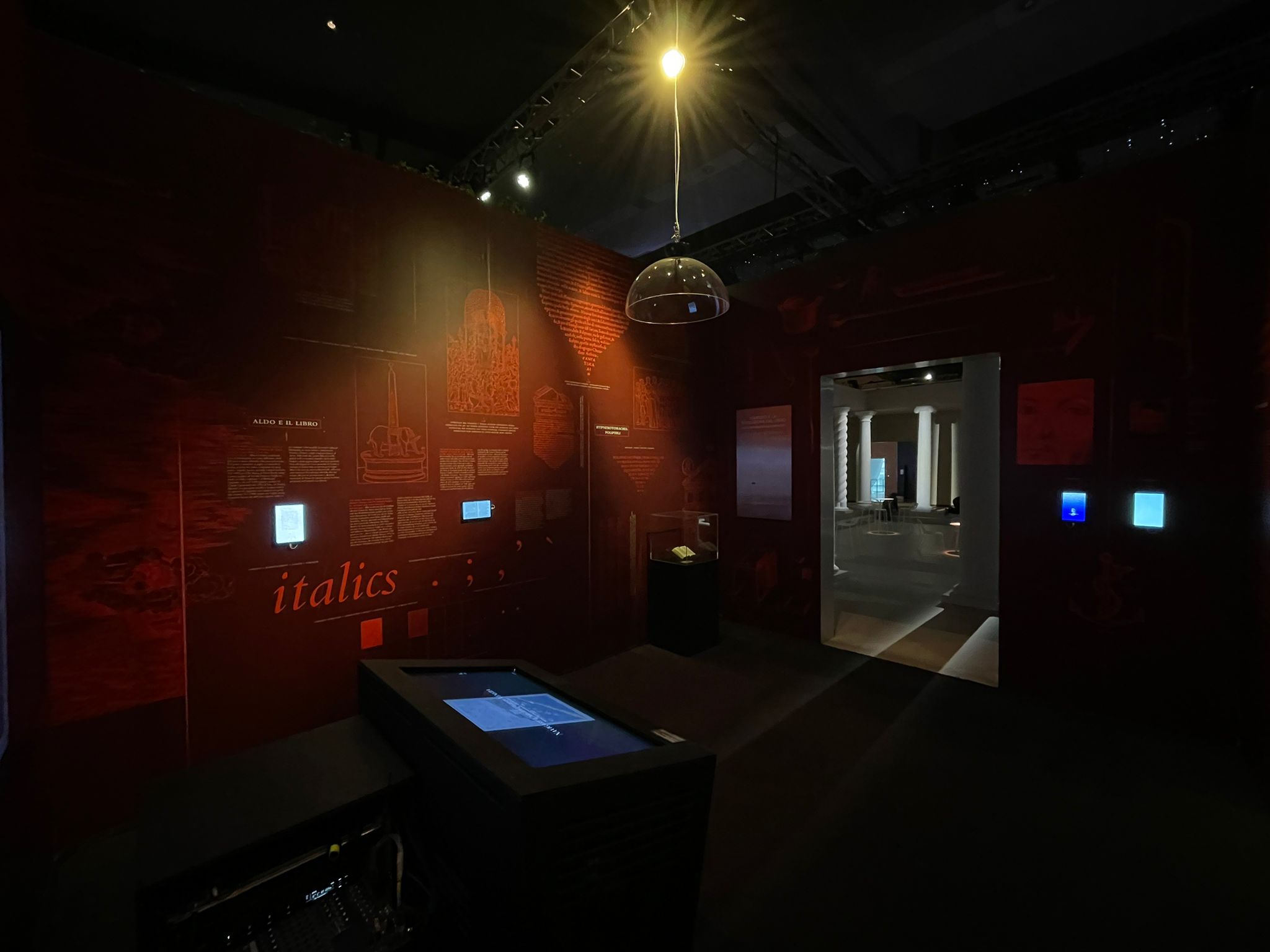Venice International University (VIU), in collaboration with Iuav University of Venice and Sabanci University in Istanbul, present the exhibition Manutius and the Book Revolution at the Italian Pavilion at the Frankfurt Book Fair, October 16-20, 2024.
The exhibition "Manutius and the Book Revolution" takes visitors on an immersive journey through Renaissance Venice, where Aldus Manutius revolutionized the world of books. Through interactive displays, the exhibition explores his life, the tools in his workshop, and the city he lived in.
Visitors can experience Venice of the time through a unique installation and learn about Manutius’ groundbreaking inventions, including the portable book format and innovations in typography that forever transformed the literary world. The exhibition also features beautiful illustrations from the most famous book printed by Manutius, the Hypnerotomachia Poliphilii, and an original Aldine edition from 1513, offering a rich exploration of his lasting legacy.
The exhibition set up in the Italian Pavilion also highlights the influence of Manutius in the Ottoman Empire.
“Gutenberg’s 42-line Bible of 1455 and Manutius’s Hypnerotomachia Poliphili of 1499 represent two extremes of the incunabula period, with equal but opposite importance. The sober, austere ‘Gutenberg Bible’ - German, Gothic, Christian, and medieval - stands in contrast to the dazzling, luxurious ‘Hypnerotomachia Poliphili' - Italian, classical, pagan, and Renaissance. These two supreme masterpieces of the printing art occupy opposite poles of humanity’s search for meaning”.
-George D. Painter (1914-2005), deputy curator of the British Museum's Incunabula department

"The book world is divided into before and after Aldo Manuzio: between the 15th and 16th centuries in Venice, the book as we know it today was developed. Manuzio is the first to print the title page, to use the editorial logo, to number the pages on both sides, to import the Greek semicolon, accent and apostrophe, and to develop the index.
The round typeface used for this pamphlet is the Bembo, developed in 1496. From 1501, Manuzio printed the classics in a small format - exactly like the one on the pages you are holding in your hand - and invented the italic typeface, which you see on the first inside page.
Shrinking the books to pocket size and printing the texts without the previously unfailing comments transformed reading forever: from then on, it took place in intimacy, in silence, in leisure time and above all for pleasure. Manuzio thus created a need: that of reading.
This makes him similar to Steve Jobs, who not only invented the iPhone, but above all created the need for a previously non-existent product. Beyond the fact that Aldo made the book the object we are still familiar with today, his most important revolution is that he made us realise that we read for pleasure."
-Umberto Vattani, President of Venice International University
Second Printing Revolution | Aldine Editions
Following the invention of the printing press and movable type by Johann Gutenberg in Mainz around 1455, a second revolution in printing came a few years later, thanks to a publisher working in Venice. It was Aldus Manutius who was active in Venice from 1494 to 1515 who invented the small book format that opened up the pleasure of individual reading. Manutius declared ‘I have made them so small that you can hold them in one hand and they can accompany you on your travels'.
The small format of the Aldine editions gave rise to silent, individual reading. Manutius introduced important innovations: the title page, punctuation, and the table of contents, so that readers could immediately understand the content. He also invented cursive, which gave the impression that the author had written the book by hand for the reader. Even today, cursive is called ‘Italic’ in many languages, referring to its printing style.
Manutius published the texts of the great Greek classics in the original language, later extending his work to Latin texts and finally to the vernacular language. His Aldine editions which were aesthetically airy and elegant, with wide margins, used high-quality typefaces and became popular across Europe. His publishing successes included the works of Dante, Bembo, Erasmus of Rotterdam and Petrarch's ‘Canzoniere’, of which over twenty thousand copies were printed.
Erasmus of Rotterdam came specifically to Venice to have his works printed in the workshop of Manutius, whom he deeply admired. To celebrate his feat, Erasmus wrote: ‘Where before libraries were contained within narrow and cramped walls, Aldus has created one that has the world by the circumference.’ His words reflected Manutius's desire to publish everything that deserved to be read. Thus a new readership was born: not only in monasteries or universities, but also among educated gentlemen and the bourgeois elite, lovers of beauty. This success was evidenced by the many letters received from ambassadors, court figures and aristocratic women. The success of the Aldine editions is immortalised in works of art, such as the painting by Giorgione depicting a gentleman holding a small book, thought to be by Aldus Manutius, contrasting with the portrait of the Duke of Urbino, depicted in front of a large, heavy book, motionless on a balustrade.
This revolution, which began in Venice in the 1500s, led to the birth of luxury editions, customised with the coats of arms of the most prestigious Venetian families, such as the Pisani, the Mocenigo and the Barbarigo.
The third revolution, 500 years later, was the work of Steve Jobs, who created an equally small and portable object: the smartphone. Just as Manutius took care of the image of his books, Jobs paid the same attention to the design of his product. The signs and symbols appear clear and legible, and the apple logo, simple and recognizable, has a similar impact to the anchor with the dolphin chosen in 1501 by Manutius, symbols of seriousness and speed in spreading culture. A perfect visualization of the motto ‘Festina lente,’ which we can translate as ‘make haste slowly’. Steve Jobs, like Manutius, created a need. Before him, there was no need for a smartphone, just as there was no desire for individual, silent reading before Manutius. Both revolutionised the way books and communication were conceived, leaving an indelible mark on culture and history.
--
VIU would like to thank the Ministry of Foreign Affairs, the Ministry of Culture, and the Centre for Books and Reading for their crucial support for this project.



























